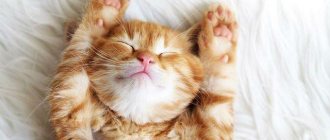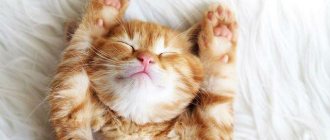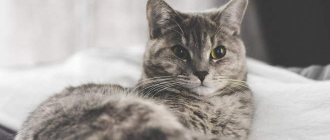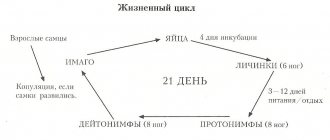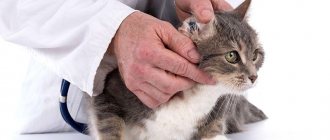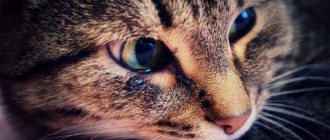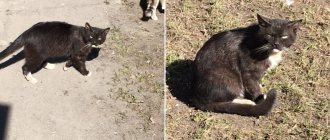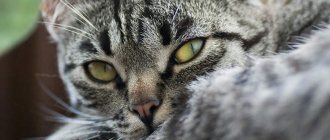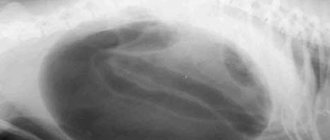The results of recent studies have confirmed what cat lovers already knew - these graceful animals become attached to their owners like children. Moreover, cats are not at all asocial animals and remember their names perfectly. However, very often communication with a cat is complicated by mutual misunderstanding: we do not always recognize not only the needs and desires of the cat, but also do not understand its behavior. But the position of the body, ears and tail can tell a lot about how these amazing animals feel. However, the most surprising results were the results of the online study catdogwelfare - you can understand its mood by the expression of a cat’s face.
A happy cat is a happy cat (and his human)
Purring and other sounds
This is the most understandable signal for such a talkative creature as a person. Everyone knows that a purring cat is a happy cat, although in fairness it should be said that she makes vibrating sounds not only when she is happy. For example, older cats may purr when approaching younger ones to show that they are friendly and do not claim power.
Animals can purr to calm themselves down in a stressful situation. But, basically, it is still a sure sign of contentment, just like meowing in certain situations. For example, when a cat enters a room and, seeing you, utters a melodious “meow”, then most often it wants to say: “I’m happy to see you! And don’t I deserve attention and affection for this?”
How to understand what a cat wants?
Although cats may seem mysterious, by carefully observing their behavior you can understand how they feel. The position of the body, head, ears and tails are hints. An anxious or frightened cat may sit down on the ground, arch its back, lower its head, and straighten its ears. By the way, people are not so different from cats - when we are scared, we also retreat back, hide, the hair on our body stands on end (this is called piloerection), and we can also fight and even bite. As for cats, when they are happy, they may approach you with their tail up and ears forward. When cats are at rest, they curl their paws or lie on their sides with their legs extended.
A cat's facial expression can also tell a lot about its mood. Researchers have found that some people can easily tell when cats are in pain. Despite this, the full range of facial expressions in cats, including in positive situations, has not been thoroughly examined.
By the way, on our Yandex.Zen channel you will find even more interesting articles about the relationship between man and our little brothers.
This cat is probably very unhappy about something.
During the online study, subjects were shown short videos of cats in various situations. Positive situations included cats approaching their owner for a treat, while negative situations included cats trying to avoid meeting a person unknown to them. The videos were carefully selected based on strict behavioral criteria and edited so that subjects could only see each cat's face, removing any other cues from the animals' body language or location.
More than 6,300 people from 85 countries took part in the study. Subjects determined whether the animal's mood in each video was positive or negative. By the way, if you want to try your hand at this difficult task, you can do it right now.
And the results obtained can be shared in the comments to this article, as well as with participants in our Telegram chat.
On average, participants identified the correct cat facial expression 59% of the time. While this estimate is little better than a common guess, it does suggest that many people have difficulty recognizing cats' emotions. However, despite the fact that most of the subjects found it difficult to understand the mood of cats, 13% turned out to be real charmers, scoring 15 or more points out of a possible 20. Mostly women fell into this group, which, according to the researchers, is not surprising - previous Research has shown that women are better at interpreting nonverbal emotional cues.
But for this guy, on the contrary, things are going uphill
Veterinarians and people who deal with large numbers of cats every day and must learn to interpret their behavior and recognize diseases also did an excellent job. What's even more surprising is that cat owners aren't as good at recognizing their pet's emotions as those who've never had a cat at home. According to researchers, this situation may be due to the fact that we recognize the emotions of our animals well, but problems may arise with interpreting the emotions of unfamiliar cats.
Fingering with paws
Cat massage - no matter how it is called in different languages! And “kneading dough”, and “kneading puree”, and “playing the piano”, and - if the cat’s claws are not trimmed - even “free acupuncture”. But no matter what fancy names they come up with for this phenomenon, its essence remains unchanged. These are the movements that kittens make while suckling their mother, kneading her belly for a better flow of milk.
Considering the pleasure that the process of eating their first food brings to babies, it is not difficult to guess that in adult life they make such movements only in moments of the highest contentment associated with a feeling of complete comfort and security.
Tail signals
The tail is the most “talking” organ of a cat. And no wonder, because it is part of the spine through which the spinal cord passes, which performs many different functions, including the transmission of signals from the brain associated with emotions. The most obvious sign of a satisfied and happy cat is its tail held high vertically.
It, like a flag over a conquered fortress, speaks of the cat’s complete victory over the surrounding space and its confidence in its own safety. No less eloquent is the small twitching of the very tip of the tail - in this way the cat expresses the joy of meeting you.
What else does a cat's tail mean?
In addition to joy, a cat's tail can express a whole range of feelings and experiences.
Take a close look at the picture: these signals show what your delicate pet is actually experiencing at the moment:
- Friendliness, contentment;
- Uncertainty;
- Disdain: “I don’t care about you!”;
- Trembling tail: “I'm glad to see you!”;
- Friendliness with a hint of uncertainty about the situation;
- Friendliness and confidence in the favorable situation;
- Defensive aggression;
- “Sweeping the floor” with the tail - aggression or irritation;
- Tousled tail - aggression;
- Potential aggression;
- Submission;
- Twitching of the tail is a warning, intense interest.
"Blind Man's Bluff"
Not only cats, but also people squint their eyes with pleasure. But if for us this is still a sign of purely physical pleasure (for example, when you decide not to give a damn about your diet and finally sink your teeth into a juicy, airy cake), then in animals this gesture is of a broader nature.
Slow and incomplete lowering of the eyelids, squinting the eyes when looking at another creature, means complete and unconditional trust in him. For cats, this means a real declaration of love. To reciprocate, you can repeat this gesture while looking at the cat.
For pleasure
Cats trample because they enjoy it. The usual pawing and releasing of claws gives them true pleasure. In the process of action, they purr loudly. You can even “read” from its face that at this moment the animal is in complete harmony with itself and the world around it. And if the object of trampling is a loving owner, then the Murka’s joy will be double.
It happens that a furry girl hurts a person during a massage with sharp claws. There is no need to push the animal away or darken her feelings with rudeness. It’s better to gently stroke her paws so that the kitty hides her prickly fingers and continues to “get high.”
"Butting"
When a cat rubs its head against your legs or face, sometimes making funny “butting” movements, it leaves on you the scent of a secretion secreted by the glands on the sides of the animal’s head. A person cannot distinguish this smell, but for a cat it is of utmost importance. Thus, she marks everything that she considers completely safe for herself. And if you have the honor of being among these selected items, then you can be sure that next to you is a completely satisfied and happy cat.
Root causes from childhood
From the moment of birth, a blind kitten searches for its mother using smell and sensation. Having found the nipple and sucked on it, the baby touches the warm body of the cat with its paws and begins to make unusual movements with them: one at a time, strongly kneading the female’s soft belly.
This unusual action of a newborn is called a “milk step.” Massaging movements, quiet smacking, contented purring of the suckling baby stimulates milk production in the mother cat. The kitten feels well-fed next to its mother, warm, cozy and safe.
An adult remembers pleasant childhood sensations next to a loving owner. Therefore, in moments of contentment and security, the fluffy beauty purrs loudly, smacks a piece of clothing, and involuntarily kneads a person’s stomach, back, legs or shoulders with her paws. In this way, the animal establishes close contact with the owner, as if telling him: “I feel good and pleasant with you, I trust you, I consider you mine.”
Ear signals
A cat's ears, although they can turn almost 180 degrees and lie almost completely against the head, are not as expressive as the tail in expressing joy. Ears raised vertically indicate both an extreme degree of interest and a warning. But those leaning slightly forward are a sign of a good, playful mood.
Maternal instinct
Procreation for a furry girl is an honorable mission. Kisunya loves being a mother; she feels boundless tenderness for her cubs. During feeding, the female purrs affectionately and moves her paws so that from the outside it seems as if she is hugging and cuddling the babies, and in case of a threat, she will fiercely protect the offspring.
A loving murka often treats his owner like his own child: he licks him, sings a song, kneads him with his paws and hugs him.
Other body signals
Cats arch their backs at times of great danger and meeting the enemy face to face. This, along with the raised fur, makes the animal visually larger and gives a chance to scare the offender before he decides to attack. But arching its back with smoothly pressed fur only means that the cat is stretching sweetly and is about to lie down comfortably to continue enjoying life.
The choice of sleeping position is also very eloquent. If your cat often sleeps on its back, exposing its most vulnerable place - its stomach, then this means the highest degree of trust in you and in everything around you. Every cat lover knows how great the temptation is to stroke a soft belly at this time. But we advise you to restrain yourself - do not destroy your pet’s trust!
It’s better to just look and be touched, remembering that tenderness is a very strong and purely positive emotion that will add to your good mood no less than tactile sensations.
If we understand happiness as a state when there is nothing more to desire, then cats, of course, have it much easier than people. Safety, satiety, some fun games - that’s all they need. So, making a cat happy is not at all difficult, but looking at an animal happy with life means, you see, to become a little happier yourself.
Larisa Solodovnikova
The period of sexual hunting
A sexually mature female during estrus is aimed at calling and searching for a male. For a girl, all other cat matters fade into the background. The cat is focused on the chosen one: in front of him she characteristically meows, arches her back, crumples the blanket, moves her paws, and releases her claws with one goal - to continue the race.
